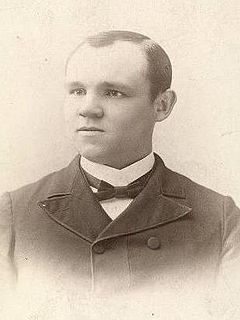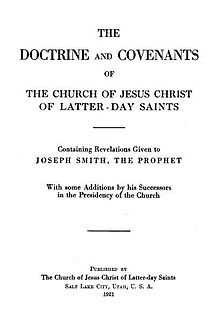| Author | James E. Talmage |
|---|---|
| Country | United States |
| Language | English |
| Publisher | The Church of Jesus Christ of Latter-day Saints |
Publication date | 1899 |
| Pages | 490 |
The Articles of Faith: A Series of Lectures on the Principal Doctrines of the Church of Jesus Christ of Latter-day Saints is an 1899 book by James E. Talmage about doctrines of The Church of Jesus Christ of Latter-day Saints (LDS Church). The name of the book is taken from the LDS Church's "Articles of Faith", an 1842 creed written by Joseph Smith.

James Edward Talmage was an English chemist, geologist, and religious leader who served as a member of the Quorum of the Twelve Apostles of The Church of Jesus Christ of Latter-day Saints from 1911 until his death.

The Church of Jesus Christ of Latter-day Saints, often informally known as the LDS Church or Mormon Church, is a nontrinitarian, Christian restorationist church that is considered by its members to be the restoration of the original church founded by Jesus Christ. The church is headquartered in Salt Lake City, Utah in the United States, and has established congregations and built temples worldwide. According to the church, it has over 16 million members and 65,000 full-time volunteer missionaries. In 2012, the National Council of Churches ranked the church as the fourth-largest Christian denomination in the United States, with over 6.5 million members there as of January 2018. It is the largest denomination in the Latter Day Saint movement founded by Joseph Smith during the period of religious revival known as the Second Great Awakening.
Within the Latter Day Saint movement, the Articles of Faith are a creed composed by Joseph Smith as part of an 1842 letter sent to "Long" John Wentworth, editor of the Chicago Democrat, and first published in the Latter Day Saint newspaper Times and Seasons. It is a concise listing of thirteen fundamental doctrines of Mormonism. Most Latter Day Saint denominations view the articles as an authoritative statement of basic theology. Some denominations, such as The Church of Jesus Christ of Latter-day Saints, have adopted the articles as scripture. For some sects, the Articles of Faith are known collectively as "An Epitome of Faith and Doctrine".
Contents
Smith's "Articles of Faith" became part of the LDS Church's scriptural canon in 1880 as part of the Pearl of Great Price. In 1891, when the First Presidency of the LDS Church asked Talmage to produce a work of theology that could be used in church schools, Talmage decided to use Smith's Articles of Faith as an outline of his work. He first delivered the material that he would organize into a book in a series of lectures delivered in 1893 at Latter-day Saints' University in Salt Lake City, Utah, which Talmage was the president of at the time.

The Pearl of Great Price is part of the canonical standard works of The Church of Jesus Christ of Latter-day Saints and some other Latter Day Saint denominations.

The First Presidency, also called the Quorum of the Presidency of the Church or simply the Presidency), is the presiding or governing body of The Church of Jesus Christ of Latter-day Saints. It is composed of the President of the Church and his counselors. The First Presidency currently consists of Russell M. Nelson and his two counselors: Dallin H. Oaks and Henry B. Eyring.
First published in 1899, Talmage's work is composed of 24 chapters. The first edition was published by the LDS Church, and has gone through over 50 English-language editions. It has also been translated and published in 13 other languages. The book continues to be published today by Deseret Book, a publishing company owned by the church.
Like Talmage's later work Jesus the Christ , Articles of Faith is today regarded as a Mormon classic. For many years, Articles of Faith and Jesus the Christ were among the few non-scriptural works that full-time LDS Church missionaries were asked to study. However, Articles of Faith is no longer part of the "approved missionary library." [1]
Jesus the Christ: A Study of the Messiah and His Mission According to the Holy Scriptures Both Ancient and Modern is a 1915 book by James E. Talmage. The book is a doctrinal study on the life and ministry of Jesus Christ and is widely appreciated by members of The Church of Jesus Christ of Latter-day Saints. The book consists of 42 chapters, each focusing on important aspects of the life and mission of Jesus as the Messiah.

Missionaries of The Church of Jesus Christ of Latter-day Saints —widely known as Mormon missionaries—are volunteer representatives of the LDS Church who engage variously in proselytizing, church service, humanitarian aid, and community service. Mormon missionaries may serve on a full- or part-time basis, depending on the assignment, and are organized geographically into missions. The mission assignment could be to any one of the 407 missions organized worldwide.








